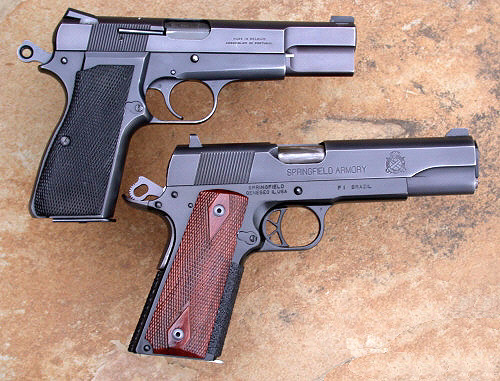
Semiautomatic Pistols: Which is best, Single-Action or DA/SA?
Folks frequently ask if the single-action automatic is "better" than the conventional double/single-action pistols which fire the first shot DA with all subsequent shots being single-action. This work will not cover the DAO automatic pistols. The reason is simple. I have no long-term, hands on experience with the DAO.
In my observation and experiences as both a police firearm instructor, private handgun instructor, and licensed concealed handgun instructor, the most efficient automatic for getting quick and accurate shots is still the old single-action automatic…but there are some provisos with that opinion.

My favorite defense automatics remain the Hi Power in 9mm and the 1911-pattern pistol in .45 ACP. That does not mean that the DA/SA automatic is "incapable" of yeoman's work in this area of concern.
The single-action auto almost always offers a lighter trigger pull than the DA/SA when the latter is being fired double-action. The single-action automatic has the same trigger pull from first shot to last. These attributes contribute to the practical accuracy of the pistol; i.e. they make it easier for the shooter to get the shots he wants.
The single-action automatic almost always requires that an external safety be disengaged if it is carried in Condition One, i.e. "cocked-and-locked." It is also less forgiving of poor gun handling with the single-action's shorter trigger pull. An errant finger on the trigger in a time of stress with the safety disengaged may very well lead to a negligent discharge. (It is true that this might be an accident, but it is due to negligence and will not happen with proper, safe handling.) 1911 pattern pistols as well as the Hi Power are single-actions requiring that the thumb safety be disengaged before they can be fired. Springfield Armory's XD-series of handguns' only external safety is grip safety. (The XD, even though striker-fired, has the striker fully retracted and is referred to as single-action. Glock handguns' strikers are only about 40% retracted and pressing the trigger fully retracts and then releases them. Some call them double-action-only but Glock refers to this as "safe action.")
It is my belief that if and only if the user is willing to practice with the single-action automatic so that automatically disengaging the thumb safety becomes second-nature and done without conscious thought, should he use one for life-or-death situations. The reason is simple. Under stress, it is very easy to simply point and pull the trigger to make the threat go away. The light, short single-action trigger-pull means nothing if in an instant of absolute terror, the external safety is not disengaged.
Some DA/SA automatics also offer an external safety. Some are ergonomically more convenient than others, but some of this breed of handgun have no external safety device. Where it is generally considered SOP to carry a single-action cocked-and-locked, the SA/DA autopistol may very well be carried with the hammer down and no external safety applied. Thus, the possibility of failing to disengage the safety in an instant of stress is removed. (This article will not get into the merits of an external safety on the DA/SA; it will focus on comparing the design with the single-action.)
The idea behind having an automatic with a longer, heavier double-action first-shot is to make the handgun "safer". Some believe that a light, short trigger pull is but an accident waiting to happen and that the DA/SA automatic minimizes it.
But is that statement true?
The answer is that it depends. It depends on the training and competency of the users. If these users are not properly trained in the use of the single-action, negligent discharges may very well occur. On the other hand, I've witnessed more than a few negligent discharges with the DA/SA automatic as well. What it amounts to in my view is that until people are properly trained, negligent discharges are very possible with either type action and that there is no substitute for competent gun handling. Neither is it an option, but a mandatory regimen for all.
It has been said that the DA/SA automatic is "a solution for a non-existent problem" and in its purity, that is probably true. On the other hand, it is not true if a person is regulated by policy, which forbids using the single-action. It is not true if a person simply cannot get used to the idea that Condition One is actually safe despite its looking "dangerous" to those not familiar with it.
The primary downside to the DA/SA automatic is the shooter has to contend with two different trigger pulls, the longer, heavier initial double-action shot and the subsequent, lighter single-action ones. In some instances we are led to believe that it is an almost insurmountable task to master.
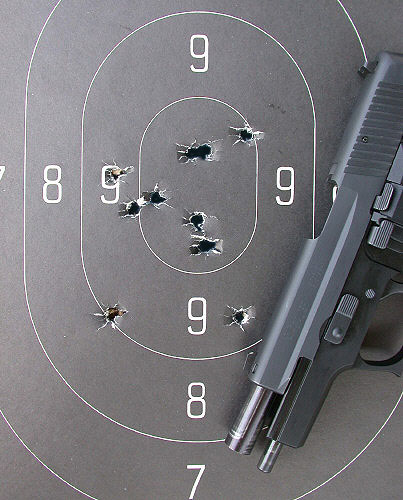
These controlled pairs were fired at 10 yards with the SIG-Sauer P-220 with each set being fired double-action for the first shot and single-action for the second. They were fired as quickly as a "flash sight picture" could be obtained.
I wonder just how true that idea is?
It has been my observation that some folks have less trouble with the transition from double to single-action than others do. Whether this is due to how the individual is "hard wired" or just a mental block, I cannot say, but it's been my experience that some rather good shooting can be done with the double-action/single-action automatic starting with a double-action first shot. It is also my observation that the DA/SA pistol must "fit" the shooter better than the single-action for this to hold true. If the reach to the DA trigger is too long for the shooter, accuracy will suffer. This is less a problem on the single-action autopistol; the trigger reach is almost always shorter than for a comparable DA/SA pistol and the shooter has to exhibit less trigger pressure over a shorter distance to fire the shot.
It has been said that the DA/SA automatic is "the badge of the incompetent."
Is that true?
I think not. Some very skilled police tactical teams use DA/SA automatics; it is required by policy and they can get the hits if required to use their handguns. The last I heard, our US Navy SEALS were using the SIG-Sauer P-226, a DA/SA 9mm pistol. I strongly suspect that they are not incompetent in its use. (Now, while I believe that some very competent folks use the DA/SA because they so mandated, I'll bet a goodly portion would jump on the opportunity to go with the single-action auto, but some might very well not.)
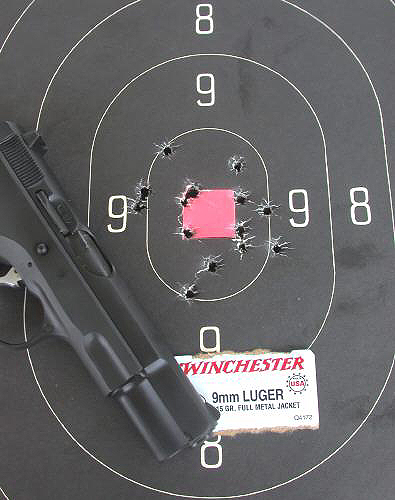
Several sets of controlled pairs were fired using this CZ-75 and Winchester 115-gr. ball. The first shot of each was fired double-action. The second was fired single-action. The DA/SA automatic is capable of good work, but it does require effort on the shooter's part.
Several years ago I decided to try some of the DA/SA automatics and see how I performed when using them instead of my lifelong single-action companions, namely the 1911 and the Hi Power. Like many other devotees of either (or both) of these pistols, no other handgun feels quite as "right" to me. Having said that, I have been able to find some DA/SA autos that work very well for me, but I fully admit to not having tried them all.
In .45 ACP my first choice remains the single-action 1911-type handgun and in the 5" length for either concealed or uniform carry, but were I going to use a DA/SA, it would be the SIG-Sauer P-220. There are several variations of this pistol now available, but the only one that I have any long-term experience with is the aluminum frame version. This pistol fits me well and its mechanical accuracy is high. I've also found it to be a reliable weapon, feeding most JHP's with nary a problem.
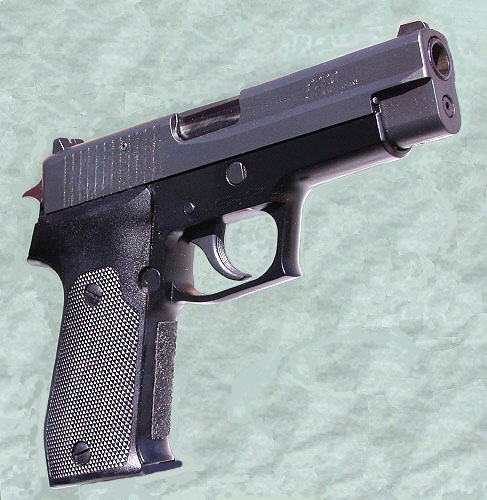
For me the SIG-Sauer P-220 has been the best I've found in 45-caliber DA/SA automatics. This one is stock except for the "custom work" amounting to a piece of anti-skid tape on the front grip strap. The gun has proven utterly reliable with JHP's and its mechanical accuracy is high.
Before the Texas Department of Public Safety went to the .357 SIG (also in a SIG-Sauer handgun), this version of the P-220 was standard issue. Texas DPS went with the .357 SIG for its ability to penetrate windshields and car doors better than the .45 ACP, not because of any particular problem with the P-220.
The DA/SA pistol I'd use in lieu of the Hi Power if required would be the CZ-75. While the trigger reach is long, it's not too long for me and the pistol offers the option of cocked-and-locked carry. The P-220 doesn't but is equipped with a convenient decocking lever. Some versions of the CZ can be had with this feature instead of the manual thumb safety.
I am not suggesting that these are the "best" choices for everyone, only that they have worked well for me. There are quite a few DA/SA pistols for folks to choose from, particularly in 9mm and .40, and I think that it's likely that a person can find one that allows them to do efficient, quick shooting. This may be an expensive proposition as there may be some trading in of guns toward others in this quest.
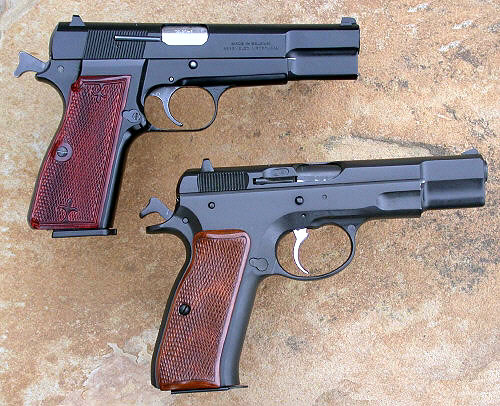
Were I unable to use the single-action Hi Power, I'd very likely go with the CZ-75 in 9mm. This one is shown with a Mk III and is capable of cocked-and-locked carry if desired.
Does the efficient use of the DA/SA automatic require more practice than the plain single-action? To me, this does seem to be the case, but it was not the difference between walking along a level sidewalk or climbing Mount Everest. It is well within the capability of any dedicated shooter in my view.
I am not bound by any requirements to use the DA/SA automatic, but for certain applications, I prefer them. One is if having to carry w/o a holster. This has not often been necessary, but when it has been I've opted for the DA/SA over my Hi Power, which has an easy-to-wipe-off safety compared to the 1911's. I simply prefer the trigger to be covered by a good holster when using my preferred single-action automatics, but if forced to carry one without a holster, it would be the 1911 and one with the GI-size thumb safety.
If everyone in my household was a shooter, I'd not opt for a DA/SA as a "house gun" but my wife is not. Her primary defense gun is a DA/SA revolver, but she can make the DA/SA automatic "work". Under stress she would probably not depress the thumb safety on single-actions.
Should you prefer the DA/SA automatic pistol, I suggest trying several if at all possible. Pay particular attention to how well your hand does or does not fit the double-stacks. Some when combined with a double-stack magazine simply have too long a trigger reach for some folks. In these instances, a single-stack pistol even from the same maker might very well be just the gun they've been looking for. Being able to properly grip the pistol is necessary for accuracy, particularly at speed, and the trading of "high capacity" for it is worthwhile in my opinion. I believe that we "solve the problem" in the first few shots and that we probably run out of time before ammunition in the private citizen deadly force scenario.
My choices may very well not be yours. Some searching and researching on the interested reader's part will almost certainly be needed to find the "right" DA/SA for him or her. Proper practice will be necessary as well and that means using the gun's double-action feature, not simply cocking the hammer for the lighter single-action pull. If commitment is less, the user would probably be better off with a single-action automatic or is simply fooling himself into believing that he's "ready" with the DA/SA, if carrying for self-protection. Whether the handgun is a revolver, SA/DA automatic, Glock or single-action auto, the user must be competent to be effective with it. That means proper practice and attention to efficiently and safely using the particular type handgun. Simply replacing the single-action auto with a DA/SA does not mean that the user is necessarily any safer or more competent. Relaxing at the range with either is quite different than suddenly having to use one to save one's own life in a panic situation.
After 30 years of serious shooting, I remain convinced that the single-action automatic is probably the most efficient fighting handgun around, but I'm equally sure that very fine work can be done with other action types as well. I do not believe that those using other than single-action automatics are doomed to failure. The dedicated DA/SA user who has practiced and learned to use his choice in this type handgun does not need to consider himself practically unarmed and he darned sure doesn't have to consider himself "incompetent" by definition.
Best.